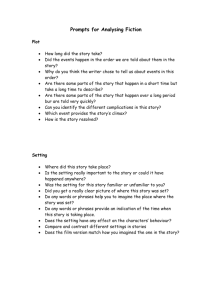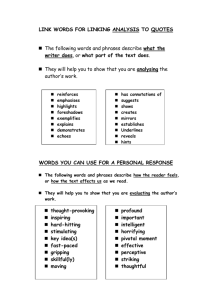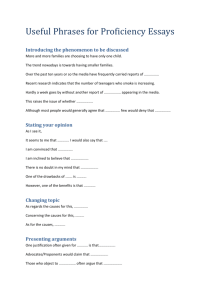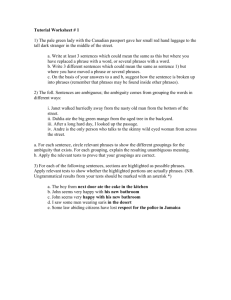WORLD LANGUAGE
advertisement
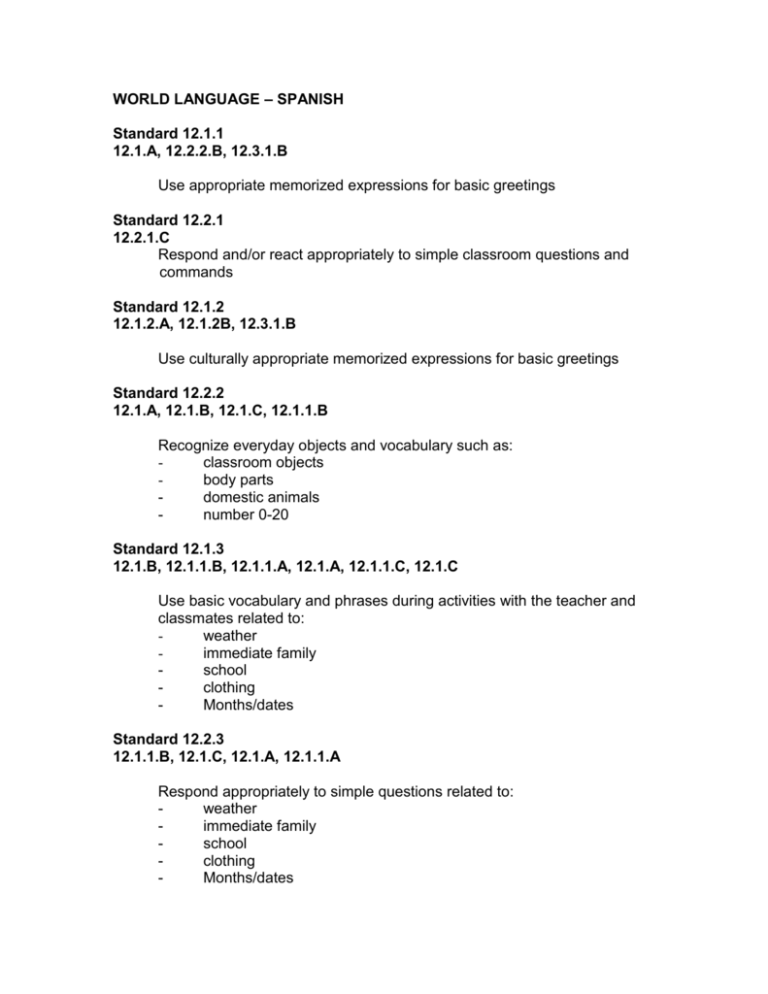
WORLD LANGUAGE – SPANISH Standard 12.1.1 12.1.A, 12.2.2.B, 12.3.1.B Use appropriate memorized expressions for basic greetings Standard 12.2.1 12.2.1.C Respond and/or react appropriately to simple classroom questions and commands Standard 12.1.2 12.1.2.A, 12.1.2B, 12.3.1.B Use culturally appropriate memorized expressions for basic greetings Standard 12.2.2 12.1.A, 12.1.B, 12.1.C, 12.1.1.B Recognize everyday objects and vocabulary such as: classroom objects body parts domestic animals number 0-20 Standard 12.1.3 12.1.B, 12.1.1.B, 12.1.1.A, 12.1.A, 12.1.1.C, 12.1.C Use basic vocabulary and phrases during activities with the teacher and classmates related to: weather immediate family school clothing Months/dates Standard 12.2.3 12.1.1.B, 12.1.C, 12.1.A, 12.1.1.A Respond appropriately to simple questions related to: weather immediate family school clothing Months/dates Standard 12.1.4 12.1.1.A, 12.1.A Recite target language alphabet and associated sounds and familiar words with proper accentuation Standard 12.2.4 12.3.A, 12.3.1.A, 12.5.C Comprehend simple written sentences in short dialogues and paragraphs related to familiar context Identify important products, cities, and foods of Latin American countries Standard 12.1.5 12.1.1.D, 12.1.D, 12.1.B, 12.1.1.A Use simple sentences and question structures in speaking and writing on familiar topics memorized words phrases expressions Standard 12.2.5 12.1.1.A, 12.1.1.B, 12.1.A, 12.1.1.C, 12.1.C Respond appropriately to simple questions relating to playing, going, having, buying, and speaking Standard 12.1.6 12.1.B, 12.1.C, 12.1.1.B Use culturally appropriate memorized expressions for basic social interactions greetings and leave-takings familiar and polite singular forms of address invitations Respond appropriately either verbally or in written form to simple questions related to: sports hobbies self-identification Standard 12.1.7 12.1.B, 12.1.1.B, 12.1.1.D Use memorized words, phrases, and expressions in speaking and writing to tell about likes / dislikes knowing how to do something wanting to do something related to familiar vocabulary Standard 12.2.7 12.1.1.B, 12.1.C, 12.1.1.C Respond appropriately either verbally or in written form to simple questions related to: familiar topics (previously learned material) likes and dislikes knowing how to do something wanting to do something school subjects and activities Standard 12.1.8 12.1.B, 12.1.1.B, 12.1.1.D Use memorized words, phrases, expressions, and questions in speaking and writing related to: going places describing people Standard 12.2.8 12.1.1.B, 12.1.C, 12.1.1.C Respond appropriately verbally or in written form to simple questions related to: going places describing people WORLD LANGUAGE – SPANISH I Standard 12.1.1 12.1.1.A, 12.1.A Speak familiar words and phrases with proper accentuation \ Standard 12.2.1 12.1.A, 12.1.B, 12.1.1.B, 12.1.1.D Speak and write using memorized words, phrases, and structures to tell and ask about: school hobbies / leisure time activities likes / dislikes basic personal information where people and things are Standard 12.3.1 12.1.1B, 12.1.1.B, 12.1.D, 12.1.1.D Write using memorized vocabulary, phrases and structures in dialogues and short narrations on the topics of: school activities Standard 12.4.1 12.1.C, 12.1.1.C Comprehend basic spoken Spanish and written sentences in dialogues, short paragraphs, and conversations which make use of familiar vocabulary Standard 12.5.1 12.1.E Recognize common words from the target language used in English Standard 12.6.1 12.3.A Identify basic aspects of the target culture, in particular relating to: Transportation Currency Christmas Geography and significant places in Spain Spanish II At the end of Spanish 2 students will be able to: →Speak basic words and phrases with proper accentuation (Stage 1 – 12.1.A, 12.1.1.A) →Speak and write using familiar vocabulary, phrases and structures to tell and ask about: Food and dining out Family Home and furnishings Places around town Going out Obligations and plans (Stage 1 – 12.1.A, 12.1.1.B, 12.1.1.D, 12.3.A, 12.3.1.A, 12.3.1.B) →Write dialogues and short narrations using familiar vocabulary, phrases and structures on the topics of: Food and dining out Family and describing people Home and furnishings Going out Movies (Stage 1 – 12.1.1.B, Stage 2 – 12.1.B, 12.1.D, 12.1.1.B, 12.1.1.D) →Comprehend simple spoken conversations and written sentences in dialogues and short paragraphs related to familiar topics (Stage 1 – 12.1.1.C, 12.1.C) →Recognize words from the target language which are used in English (Stage 1 – 12.1.E) →Identify aspects of the target culture, in particular those relating to: Holidays Foods Daily Schedule Family Latin America →Identify where in the national and global community the target language’s culture is experienced (Stage 1 – 12.5.A) Spanish III At the end of Spanish 3 students will be able to: →Speak and model phrases and sentences with accepted pronunciation and intonation with survival proficiency (Stage 2 – 12.1.A, 12.1.1.A) →Speak and write using simple and compound sentence and question structures to form new sentences using previously learned material, form original questions, and respond spontaneously to questions on the topics of: Everyday activities Personal information Memorable and upcoming events (Stage 2 – 12.1.D, 12.1.1.D) →Speak and write using extended vocabulary phrases and structures in dialogues and short narrations on the topics of: Everyday activities Memorable and upcoming events Topics of personal information (Stage 2 – 12.1.B, 12.1.1.B, 12.1.A, 12.1.D) →Comprehend simple spoken and written sentences which make use of expanded vocabulary in dialogues and short passages on the topics of: Common everyday activities Personal information exchange Areas of personal interest Directions and commands (Stage 2 – 12.1.B, 12.1.1.C, 12.1.C) →Identify words from the target language that are commonly used in English (Stage 1 – 12.1.E, Stage 2 – 12.1.C) →Describe fundamental customs of the target culture, in particular those pertaining to: Holidays Schedules Social interactions (Stage 1 – 12.3.A, 12.3.1.A) →Identify where in the local, national, and global community the target language and culture are useful (Stage 1 – 12.1.A, 12.1.1.A) →Speak and model phrases and sentences with accepted pronunciation, rhythm, and intonation with survival level proficiency (Stage 2 – 12.1.A, 12.1.1.A) → Create and use simple and compound sentences and questions to communicate and comprehend: Simple survival tasks Everyday activities Personal information Memorable and upcoming events Opinions Simple commands and directions →Speak and write using expanded vocabulary phrases, idioms, and compound structures in dialogues and narrations on the topics of: Simple survival tasks Everyday activities Personal information Memorable and upcoming events Opinions Simple commands and directions (Stage 2 – 12.1.B, 12.1.1.B, 12.1.A, 12.1.D) →Comprehend and respond to spoken and written questions, sentences, and paragraphs which use expanded vocabulary and structures on the following topics with minimal reliance on translation: Simple survival tasks Everyday situations Personal information Memorable and upcoming events Opinions Simple commands and directions (Stage 2 – 12.1.B, 12.1.C, 12.1.1.C) →Identify words that are commonly used in English which have origins in the target language (Stage 2 – 12.1.E, 12.1.C) →Compare and contrast customs of the target culture and U.S. cultural traditions, in particular those relating to: Holidays Schedules Social interactions (Stage 1 – 12.3.A, 12.3.A) →Identify vocabulary terms in the target language which are associated with holidays in the target culture and with U.S. holidays (Stage 1 – 12.3.A, 12.3.1.A) →Identify national employment opportunities where the target language is an advantage or a requirement for employment (Stage 3 – 12.5.A, 12.5.B, 12.5.D) Curriculum Alignment 1-5 Spanish Grade 1 – 1 day per week – ½ hour Grade N – S – O Basic greetings Some body parts Numbers 0-20 Colors Days of the week Grade 2 – 1 day per week - ½ hour Grade N – S – O Begin reading and writing Reinforce grade 1 learning Tu/Usted Classroom objects Body parts – expanded Domestic animals Introduce the alphabet Grade 3 – 1 day per week – 40 minutes Grade N – S – O Reinforce grade 1 and 2 learning Weather Create conversations Immediate family vocabulary Months / dates Basic clothing items Some gender distinction Additional school vocabulary Alphabet Grade 4 – 1 day per week – 40 minutes Grade N – S – O Reinforce grade 1,2, and 3 learning Pledge of Allegiance Alphabet review Some reading for content Culture – Spanish speaking countries in the Americas Regional differences Foods Products Language differences Monuments Famous people Early civilizations Numbers 0 -40 Introduce time Grade 5 – 1 day per week – 40 minutes Grade N – S – O Reinforce grade 1, 2, 3, and 4 learning Introduce present tense forms of the verbs: Jugar, tener, ir, comprar, hablar Numbers 0 - 60 Time Culture – Spain Spanish artists Spanish authors Products Food Floats to represent regions Some writing Conversational Spanish German German I At the end of German I students will be able to: →Speak familiar words and phrases with proper accentuation (Stage 1 – 12.1.1.A, 12.1.A) →Use basic vocabulary and phrases during activities with the teacher and classmates related to: Basic greetings Numbers Standard and 24 hour time Weather Family members Leisure time activities (Stage 1 – 12.1.A, 12.1.1.A, 12.1.1.B, 12.1.1.C, 12.3.1.B) →Respond and/or react appropriately to simple classroom questions and commands (Stage 1 – 12.1.C) →Know and appropriately apply concepts and structures related to: Family Housing and furniture Festivals and holidays (Stage 1 – 12.1.A, 12.1.1.B, 12.1.B, 12.3.A, 12.3.1.AZ, 12.3.1.B) →Use simple sentence and question structure in order to communicate in relation to familiar topics (Stage 1 – 12.1.D, 12.1.1.D, 12.1.A) →Identify aspects of the target culture, in particular relating to: Holidays and celebrations Currency Family Housing Basic social interactions (Stage 1 – 12.3.C, 12.3.A, 12.3.B) →Identify common words in the target language which are used in English or have origins in the target language (Stage 1 – 12.1.E) →Recognize where in the national and global community the target language and culture are experienced (Stage 1 – 12.5.A) German II At the end of German 2 students will be able to: →Speak basic words and phrases with proper accentuation (Stage 1 – 12.1.A, 12.1.1.A) →Speak and write familiar phrases and structures in order to tell or ask about: Health issues Clothing Travel and accommodation Transportation Geography School (Stage 1 – 12.1.A, 12.1.1.B, 12.1.B, 12.1.1.D, 12.3.A, 12.3.1.A, 12.3.1.B) →Write dialogues and short narratives using familiar vocabulary, phrases and structures on topics relating to: Travel and accommodation Clothing Transportation School Health issues (Stage 1 and 2 – 1q2.1.1.B, 12.1.1.D, 12.1.D) →Recognize words from the target language which are used in English or have origins in the target language (Stage 2 – 12.1.E) →Identify where in the national and global community the target language and culture are experienced (Stage 1 – 12.5.A) →Identify aspects of the target culture, in particular those relating to: Travel and accommodations German speaking nations Geography Family Housing School (Stage 2 – 12.3.C, 12.3.B) →Use simple sentence and question structures to communicate about daily activities, social amenities, and personal life (Stage 2 – 12.1.1.D) German III At the end of German 3 students will be able to: →Speak and model phrases and sentences with accepted pronunciation and intonation with survival level proficiency (Stage 2 – 12.1.A, 12.1.1.A) →Speak and write expanded vocabulary phrases and structures in dialogues and short narratives (Stage 2 – 12.1.D, 12.1.1.D) →Develop and use compound sentence and question structure to communicate and comprehend Compositions Main ideas of culturally authentic materials (Stage 3 – 12.1.1.D, 12.1.D) →Comprehend simple spoken and written sentences which make use of expanded vocabulary in dialogues and short passages on the topics of: Common everyday activities Personal information exchange Areas of personal interest Directions and commands (Stage 2 – 12.1.B, 12.1.1.C, 12.1.C) →Describe fundamental customs of the target language culture in particular those relating to: Social interactions Poplar culture (Stage 1 – 12.3.A, 12.3.1.A) →Identify where in the local, national, or global community the target language and culture are useful (Stage 1 – 12.4.A, 12.5.B, 12.5.C) German IV At the end of German 4 students will be able to: →Speak and model phrases and sentences with accepted pronunciation rhythm, and intonation with survival level proficiency (Stage 2 – 12.1.A, 12.1.1.A) →Create and use simple and compound sentences and questions to communicate and comprehend Simple survival tasks Everyday activities Personal information Opinions Simple commands and directions (Stage 2 – 12.1.1.D, 12.1.D) →Speak and write using expanded vocabulary, phrases, idioms, and compound structures in dialogues and narration on topics of: Simple survival tasks Everyday activities Personal information Opinions Simple commands and directions (Stage 2 – 12.1.B, 12.1.A, 12.1.1.B, 12.1.D) →Compare and contrast customs of the target culture and U.S. cultural traditions (Stage 1 – 12.3.A, 12.3.1.A) →Use simple, compound, and complex sentence and question structures in order to communicate and comprehend (Stage 3 – 12.1.D, 12.1.1.D) →Recognize expanded vocabulary through reading, listening, speaking, and writing (Stage 2 – 12.1.C, 12.1.1.B) French French I At the end of French 1 students will be able to: →Speak basic words and phrases with proper pronunciation and accentuation (Stage 1 – 12.1.A, 12.1.1.A) →Use basic vocabulary and phrases during activities with the teacher and classmates related to: Basic greetings Numbers Standard and 24 hour time Weather Food Family Leisure time activities (Stage 1 – 12.1.A, 12.1.1.A, 12.1.B, 12.1.1.C, 12.3.1.B) →Respond and/or appropriately to simple classroom questions or commands (Stage 1 – 12.1.C) →Know and appropriately apply concepts and structures which relate to: Family Leisure time activities Housing and furniture Foods (Stage 1 – 12.1.A, 12.1.1.B, 12.1.B, 12.1.D, 12.3.A, 12.3.1.A, 12.3.1.B) →Use simple sentence and question structure in order to communicate in relation to familiar topics (Stage 1 – 12.1.D, 12.1.1.D, 12.1.A) →Identify aspects of the target culture in particular relating to: Holidays and celebrations Currency Family Housing Basic social interactions →Identify words in the target language which are used in English or have origins in the target language (Stage 1 – 12.1.E) →Recognize where in the national and global community the target language and culture are experienced (Stage 1 – 12.5.A) French II At the end of French 2 students will be able to: →Speak basic words and phrases with proper accentuation (Stage 1 – 12.1.A, 12.1.1.A) →Speak and write familiar phrases and structures in order to tell or ask about: Towns Housing Family Leisure time activities Directions (Stage 1 – 12.1.A, 12.1.1.B, 12.1.1.D, 12.3.A, 12.3.1.A, 12.3.1.B) →Write dialogues and short narratives using familiar vocabulary, phrases and structures on topics relating to: Towns Housing Family Leisure time activities Directions (Stage 1 and 2 – 12.1.1.B, 12.1.1.D, 12.1.D) →Recognize words from the target language which are used in English or have origins in the target language (Stage 2 – 12.1.E) →Identify where in the national and global community the target language and culture are experienced (Stage 1 – 12.5.A) →Identify aspects of the target culture, in particular those relating to: Towns Housing Family Leisure time activities Directions (Stage 2 – 12.3.C, 12.3.B) →Use simple sentence and question structures to communicate about daily activities, social amenities, and personal life (Stage 2 – 12.1.1.D) French III At the end of French 3 students will be able to: →Speak and model phrases and sentences with accepted pronunciation and intonation with survival level proficiency (Stage 2 – 12.1.A, 12.1.1.A) →Speak and write expanded vocabulary, phrases and structures in dialogues and short narratives (Stage 2 – 12.1.D, 12.1.1.D) →Develop and use compound sentence and question structure to communicate and comprehend Compositions Main ideas of culturally authentic materials (Stage 3 – 12.1.1.D, 12.1.D) →Comprehend simple spoken and written sentences which make use of expanded vocabulary in dialogues and short passages on the topics of: Common everyday activities Personal information exchange Areas of personal interest Directions and commands (Stage 2 – 12.1.B, 12.1.1.C, 12.1.C) →Describe fundamental customs of the target language culture in particular those relating to: Social interactions Popular culture →Identify where in the local, national, or global community the target language and culture are useful (Stage 1 – 12.4.A, 12.5.B, 12.5.C) French IV At the end of French 4 students will be able to: → Speak and model phrases and sentences with accepted pronunciation, rhythm, and intonation with survival proficiency (Stage 2 – 12.1.A, 12.1.1.A) →Create and use simple and compound sentences and questions to communicate and comprehend Simple survival tasks Everyday activities Personal information Opinions Simple commands and directions (Stage 2 – 12.1.1.D, 12.1.D) →Speak and write using expanded vocabulary, phrases, idioms, and compound structures in dialogues and narration of topics of: Simple survival tasks Everyday activities Personal information Opinions Simple commands and directions (Stage 2 – 12.1.B, 12.1.A, 12.1.1.B, 12.1.D) →Compare and contrast customs of the target language culture and U.S. cultural traditions (Stage 1 – 12.3.A, 12.3.1.A) →Use simple, compound, and complex sentence and question structures in order to communicate and comprehend (Stage 3 – 12.1.D, 12.1.1.D) →Recognize expanded vocabulary through reading, listening, speaking, and writing (Stage 2 – 12.1.C, 12.1.1.B)


